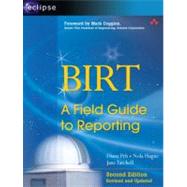
What is included with this book?
| Foreword? | p. xix |
| Preface? | p. xxiii |
| Acknowledgments? | p. xxix |
| Installing BIRT | p. 1 |
| Prerequisites for BIRT | p. 3 |
| Downloading Eclipse BIRT components | p. 3 |
| BIRT Report Designer software requirements | p. 5 |
| About types of BIRT builds | p. 7 |
| Installing a BIRT Report Designer | p. 9 |
| Installing BIRT Report Designer Full Eclipse Install | p. 9 |
| Installing BIRT RCP Report Designer | p. 10 |
| Troubleshooting installation problems | p. 11 |
| Installing a language pack | p. 13 |
| Updating a BIRT Report Designer installation | p. 14 |
| Updating BIRT RCP Report Designer installation | p. 15 |
| Getting Started | p. 17 |
| Learning the Basics | p. 19 |
| About BIRT reports | p. 19 |
| Overview of the report design process | p. 19 |
| About the report design environment | p. 21 |
| Viewing sample reports | p. 30 |
| Tutorial 1: Building a simple listing report | p. 32 |
| Planning Your Report | p. 53 |
| Identifying the content of the report | p. 54 |
| Determining how the report will be viewed | p. 55 |
| Considering international reporting requirements | p. 56 |
| Deciding the layout and format of the report | p. 56 |
| Drawing a mock-up | p. 58 |
| Considering reuse of report components | p. 58 |
| Managing report design resources | p. 59 |
| Deciding how the report will be deployed | p. 59 |
| Accessing and Bi | |
| Table of Contents provided by Publisher. All Rights Reserved. |
The New copy of this book will include any supplemental materials advertised. Please check the title of the book to determine if it should include any access cards, study guides, lab manuals, CDs, etc.
The Used, Rental and eBook copies of this book are not guaranteed to include any supplemental materials. Typically, only the book itself is included. This is true even if the title states it includes any access cards, study guides, lab manuals, CDs, etc.